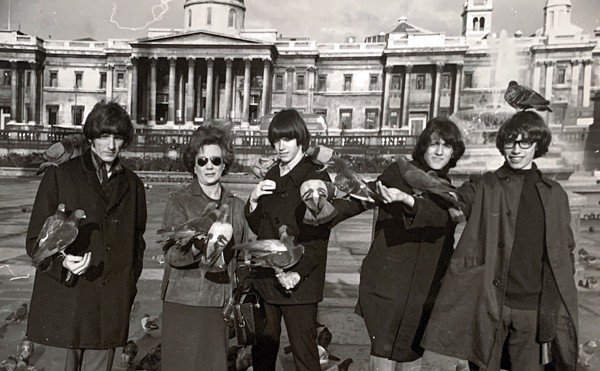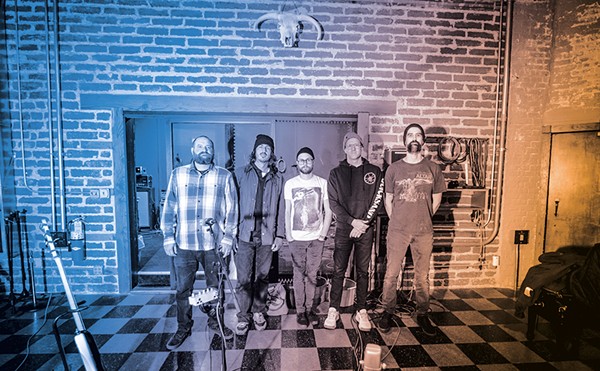Like the history of everything else, punk's history is written by the winners even as the most significant part of its present is always written by the losers. Godfathers from Iggy Pop to the Descendents will always play to large, excited audiences, no matter how many crappy records they've released since their heyday. But punk at its most meaningful resides not in any one band, or canon of bands, but in the thousands of bands in hundreds of scenes across the world -- bands that tend not to last long or leave a very deep footprint once they're gone.
Punks have also had an ambivalent relationship with technology. Sure, punks depend on electricity and everything, but technology plays the villain in many punk-rock dystopias. It has its uses, but it's probably not to be trusted. A certain segment of the punk audience will never buy a recording with a synthesizer on it. More broadly, punk's emphasis on spirit and spontaneity over technique puts it at odds with the culture of technology.
Punks were among the first critics of the Internet, and their wildest satires on the subject were quickly surpassed by reality. It should surprise no one that there is an AnarchoPunk Web Ring, much less that www.punkrock.org is a tremendously successful site. Like the Amish (no, seriously), punks will embrace technology when it helps build community. Granted, your average teenage punk-rock goofball probably won't think of it that way. But when he complains on a message board about the Nazi bouncers at last night's show, "building community" is exactly what he's doing.
Jerome Gaynor is responsible for thousands of such interchanges over the past few years, as well as a growing body of historical punk lore. He's the creator of the St. Louis Punk Page (www.stlpunk.com), a one-stop local punk Web site that receives several hundred visitors a day. Some come to check the calendar of local punk shows, some to talk smack on the notoriously unmoderated message boards and some to play the "very easy video game." (This last attraction allows players to drop a nuclear device onto downtown St. Louis, to the delight of a nearby zombie.)
A chance encounter with a Dead Milkmen record in the mid-'80s convinced the teenage Gaynor that punk rock was his way out of a dull South County existence. Years passed in a haze of vandalism, skateboarding, ludicrous hairdos and Agent Orange records, punctuated by disciplinary troubles at St. Louis University High School. By the early '90s, Gaynor had become an accomplished comics artist with his zine Funkapotamus. The emotional depth and sharp humor of his cartoonishly drawn tales of suburban frustration attracted notice in the alternative-comics scene, and to this day he enjoys friendships and working relationships with cartoonists ranging from Jessica Abel to Alexander Zograf. He's already edited and published Flying Saucer Attack, a well-received anthology featuring stories about a catastrophic alien invasion; in January he plans to launch Bogus Dead, a similar volume about a zombie uprising. Both use horror themes to tell tales full of insight and humor, from a wide variety of indie-comics all-stars.
Of course, all this means little to bill collectors; Gaynor always had to work a day job to fund his drawing habit. In 1995, a collision of commerce and commitment gave birth to the first version of the Punk Page. "I had a chance to get a job making Web sites for Jeff Parks, who's now the owner of the Creepy Crawl," Gaynor says. "He'd seen my comic books; he liked my artwork. So I started making Web sites, and it immediately occurred to me, since I was all into punk at the time, to make a Web site about the local punk scene." Gaynor maintained the site for about two years, but it was too labor-intensive for him to keep up. "I'd have to put up every band page myself," he says. "I'd have to go to a show, talk to a band, get their names and the names of their records and stuff, and then type it all in and make a separate Web page for each band. It was just too time-consuming."
The site fell into disrepair for a time, and another, unrelated St. Louis punk site served the masses. But as Gaynor learned more about programming, he began to see how much he could improve his old site. He revived the St. Louis Punk Page in 2000, in a new turbocharged version, still without any kind of recompense for himself. "I was able to make it all automatic, where the bands could come in, get a password, make their own page and make changes to it." Bands, including many that were long defunct, flocked to set up pages on the site.
Gaynor was also able to add a message board to each band page. He decided not to spend his time micromanaging the boards, leaving them as wide-open free-speech zones, and they rapidly drew crowds. The fact that an average of 200 new messages appear on the site every day suggests that the punk youth of St. Louis appreciate this hands-off approach. "I definitely think it's important for people -- kids, especially -- to have an arena where they can discuss things where they're not under surveillance by anybody," Gaynor says.
Although he admits that the message boards sometimes degenerate into lunkheaded attempts at juvenile humor, Gaynor sees it as a price worth paying. "It's so easy to write a bad word and hit 'enter,'" he says. "But it's also pretty easy to ignore that stuff, and sometimes it adds up to an amusing spectacle." Of course, not all adults are thrilled by the idea of an unsupervised online forum for their kids. To keep the site out of trouble, Gaynor will step in, in certain cases, to delete something particularly offensive. "Just about a week ago," Gaynor says, "I got an e-mail from an angry parent who had discovered that his family was being slandered on one of the pages in a fairly obscene manner. I was happy to take the stuff down; it was just a bunch of obscene things about this guy's mom. I never edit the site unless somebody specifically asks, and I also don't let people retract what they say. I hope that balances it out, restrains people a little bit."
Not all of the message-board posters are minors. Several pages have drawn grown-up punk veterans eager to swap tales of their bad old days. "I'd say once a week I get an e-mail from some old punk person from St. Louis who's really excited about it," he says. The pages for bygone bands such as Mean Guys From Hell contain stories like this one: "... He pulled a .22 caliber pistol, loaded with blanks, from his sock, shot into the audience several times, then aimed at his head and shot once more, falling to the floor. Naïve about blanks, he was surprised by the powder burns he received on his neck."
The historical aspect of the site is important to Gaynor, who's interested both in the history of pop culture and in local history. The site features an archive of old punk fliers from the private collection of Jim Utz (Vintage Vinyl advertising and promotions director and longtime scenester). Gaynor would like the site's history section to grow, but he's already been surprised at some of the things he's learned. "Finding out about the Welders was cool," he says. "An all-girl punk band from the '70s from St. Louis -- that's kind of unusual."
Unfortunately, Gaynor's dream of putting old St. Louis punk music online has been hard to realize. The site features links to MP3s that are located elsewhere on the Web, but no music resides on its servers yet. "One of the things with putting music on the Web is that it takes an enormous amount of space to store it," he explains. "If anybody out there knows of anyone that wants to host it that would be fairly stable, please let me know."
Anybody got a few megs for the kids? It's the old punk plea for mutual assistance in a brand-new form. If Jerome Gaynor has his way, the punk ethic may mutate and evolve, but it'll never disappear again.





